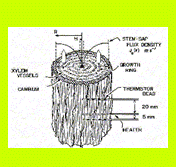

|
Tranzflo NZ Ltd |


|
Specialists in Sap Flow Sensors |
|
Heat pulse theory—idealized |
|
Tranzflo NZ Ltd, 15 Parata St, Palmerston North 4410, NEW ZEALAND Tel: +64-6-357-4600 Fax: +64-6-357-4601 E-mail: stevegreen@inspire.co.nz |
|
Heat-pulse methods date back some 70 years to the work of Huber (1932) who first conceived the idea of using heat as a tracer of sap flow. Some fifty years later Marshall (1958) developed a theoretical framework for heat-pulse, based on a set of analytical solutions to the following heat flow equation, that ideally represents the two dimensional pattern of temperature surrounding a line heater of zero dimension that is inserted into a section of sapwood of uniform physical and thermal properties. Here, T is the temperature departure from ambient [K], t is time [s], λ is the thermal conductivity [W m-1 K-1] in the axial (x) and tangential (y) directions, a is the fraction of xylem cross-sectional area occupied by sap streams moving with a velocity u in the x-direction, and Q is the amount of internal heat that is released from the heater [W m-3].
There is a simple relationship between the heat-pulse velocity, V [m s-1], and the sap flux density, JS = au [m s-1], that is given by where ρ is the density [kg m-3], c is the specific heat capacity [J s-1 m-1 K-1] and the subscripts s and w refer to the sap and the fresh wood, respectively. Following the application of a heat-pulse, the temperature rise, T, at a distance of where Swanson (1962) was one of the first to utilize Marshall’s analytical solutions, in his analysis of the ‘compensation’ heat-pulse method where two temperature sensors are placed asymmetrically either side of a line heat source. Swanson showed that if the temperature rise is measured at distances xU [m] upstream and xD [m] downstream from the heater, then the heat-pulse velocity can be calculated from
where tZ [s] is the time delay for the temperatures at points xD and xU to become equal. Equation [4] implies that the centre of the heat-pulse is convected downstream from the heater to reach a point mid-way between the two temperature sensors after a time tZ. Marshall’s (1958) analytical theory was also used by Cohen et al. (1981) to develop an alternative ‘improved heat-pulse method’ that relies on measuring the time, tM, for a maximum temperature rise to be recorded by a single sensor located a distance xD downstream from a line heater. We shall refer to this as the ‘T-max’ method. The heat-pulse velocity, VM [m s-1] is calculated from
The only other factor required to determine VM is the thermal diffusivity, κ, which is determined from the following equation
that is calculated at times when zero sap-flow occurs. The condition VM = JS = 0 normally occurs at night, when vapour pressure deficits are low, leaf stomata have closed and transpiration losses are close to zero. We refer to the estimate of V [m s-1] from Eqs 4 and 5 as the ‘raw’ heat-pulse velocity.
|
|
To contact us: |




